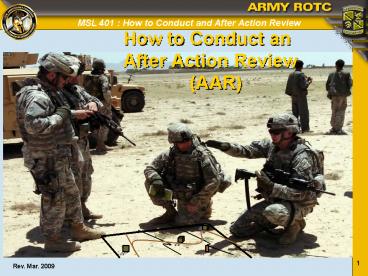How to Conduct an After Action Review AAR - PowerPoint PPT Presentation
1 / 14
Title:
How to Conduct an After Action Review AAR
Description:
Review materials. Training & evaluation plan. Army Training ... Review training objectives, orders, METL, and doctrine. Identify key events OCs are to observe ... – PowerPoint PPT presentation
Number of Views:2166
Avg rating:3.0/5.0
Title: How to Conduct an After Action Review AAR
1
How to Conduct anAfter Action Review
(AAR)
2
What is an AAR?
- A professional discussion of an event that
enables soldiers to discover for themselves - WHAT happened
- WHY it happened
- HOW to sustain strengths improve weaknesses
- An opportunity to capture lessons learned
Improves individual and collective performance by
providing immediate feedback
3
AAR A Multipurpose Tool
- Guide unit toward achieving training objectives
- Identify lessons learned so they can be applied
in subsequent training - Increase confidence in unit leaders
- Increase proficiency of all participants
4
Critical Elements of a Successful AAR
5
Two types of AAR
VS
Use the AAR that best fits your situation
Source TC 25-20
6
Phase 1 PLAN
- Establish objectives
- Select train qualified OCs
- Review materials
- Training evaluation plan
- Army Training Evaluation Program (ARTEP)
- Mission Training Plans (MTPs)
- Soldier Training Publications (STPs)
- Determine timing identify participants
- Plan for stop points during AAR
- Select potential sites
- Select prepare training aids
- Draft review AAR plan
7
AAR Plan WorksheetExample
Source TC 25-20, Figure 2.1
8
Phase 2 PREPARE
- Review training objectives, orders, METL, and
doctrine - Identify key events OCs are to observe
- Observe training take notes
- Collect observations from other OCs
- Organize observations to identify key discussion
points - Recon prepare selected AAR site
- Conduct rehearsals
9
AAR Observation Worksheet Example
Source TC 25-20, Figure 3.1
10
Phase 3 CONDUCT
- Introduction and AAR rules of engagement
- Review of objectives intent
- Training objectives
- Mission what was supposed to happen?)
- Relevant doctrine, tactics, techniques, and
procedures (TTPs) - Summary of recent events (what happened?)
11
AAR Rules of EngagementExample
- This is a learning event, not a critique
- Everyone should participate
- Does not measure success or failure
- Be thick-skinned
- No sleeping, eating, or smoking
12
Phase 3 CONDUCT (continued)
- Discussion of key issues
- Chronological order of events
- Battlefield operating systems
- Key events/ themes/ issues
- Plan, prepare, and execute (technique)
- Discussion of other issues
- Soldier/ Leader skills
- Tasks to sustain/ improve
- Fratricide
13
AAR Key Leader AssessmentExample
14
Phase 4 FOLLOW-UP






























